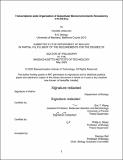Transcriptome-wide organization of subcellular microenvironments revealed by ATLAS-Seq
Author(s)
Adekunle, Danielle(Danielle Aduke)
Download1241091855-MIT.pdf (8.257Mb)
Other Contributors
Massachusetts Institute of Technology. Department of Biology.
Advisor
Eric T. Wang and Phillip A. Sharp.
Terms of use
Metadata
Show full item recordAbstract
Subcellular localization of RNAs is a ubiquitous and evolutionarily conserved process that provides an additional layer of transcriptome organization promoting coordinated control of gene expression in both space and time. It has been shown to contribute to processes ranging from cell fate determination and embryonic patterning to local translation and directed cell movement. Elegant efforts focused on a small handful of RNAs have established RNA localization to play key roles in cell function - yet recent studies suggest that specific localization patterns are the rule, not the exception, across the transcriptome. We still lack global maps and organizing principles for how RNAs are localized in cells and tissues. This dissertation details the findings of a new approach to investigating RNA localization on a transcriptome-wide scale, ATLAS-Seq, a detergent-free method that generates transcriptomes and proteomes from tissue lysates fractionated across a continuous sucrose gradient by density ultracentrifugation. We conducted proteomic analyses of fractions to determine separation of subcellular compartments. Transcriptomic analyses revealed that RNAs sedimenting similarly across gradients encode proteins in similar protein complexes, cellular compartments, or with similar biological functions, suggesting that RNAs that are functionally related are cosegregated to be coregulated. Overall, most RNAs sedimented differently than their encoded protein counterparts, signifying that most RNA compartmentalization is not directed at restricting RNA localization to the final destination of their protein product. To identify regulatory RNA binding proteins potentially driving these patterns, we correlated their sedimentation profiles to all RNAs, confirming known protein-RNA interactions and predicting new associations. Interestingly, hundreds of alternative RNA isoforms exhibited distinct sedimentation patterns across the gradient, despite sharing most of their coding sequence. These results provide new insights into establishment and maintenance of subcellular organization of the transcriptome.
Description
Thesis: Ph. D., Massachusetts Institute of Technology, Department of Biology, May, 2020 Cataloged from student-submitted PDF of thesis. Includes bibliographical references.
Date issued
2020Department
Massachusetts Institute of Technology. Department of BiologyPublisher
Massachusetts Institute of Technology
Keywords
Biology.